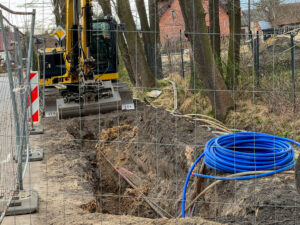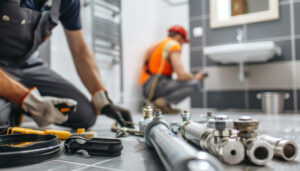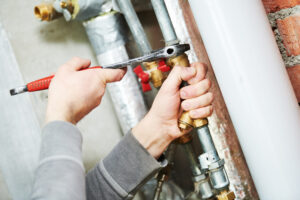The night my downstairs bathroom decided to stage a rebellion is etched into my memory with painful clarity.
I’d ignored the warning signs for weeks – the subtle gurgle when I brushed my teeth, that faint sewage smell I convinced myself was just my imagination.
“I’ll get to it next weekend,” became my mantra until 3 AM on a Tuesday when I woke to the unmistakable sound of water where water shouldn’t be.
Standing ankle-deep in murky water at an hour when plumbers charge triple, I had a moment of perfect clarity: our homes speak to us long before they scream.
I share this not to showcase my own stubborn denial but because I’ve since learned that most plumbing disasters follow this same pattern – modest warnings dismissed until catastrophe strikes.

Is Your Drain Hole Clogged? We Can Help
In the five years since becoming a homeowner, I’ve developed a near-obsessive attention to the subtle communications our plumbing systems offer. That vigilance has saved me thousands and spared my home from the kind of water damage that haunts insurance adjusters’ nightmares.
The Language of Troubled Pipes
Our plumbing systems lack the ability to send text alerts or flash warning lights when problems develop. Instead, they communicate through a nuanced language of sounds, smells, and visual cues that most of us haven’t been taught to interpret. Learning this language isn’t just useful – it’s the difference between a quick fix and a four-figure emergency.
Decoding the Drain Gurgle: Your Pipe’s Distress Call
That distinctive glug-glug-glug from your drains isn’t random noise – it’s a precise diagnostic message. When water should flow silently down a properly vented drain but instead creates that telltale gurgle, what you’re actually hearing is air being forced through water where it shouldn’t be. This disruption usually indicates one of three specific problems.
Most commonly, it signals a developing clog that’s already restricting proper flow. Like a river narrowing before a dam, the water’s smooth journey is being interrupted, creating turbulence that forces air to bubble back through standing water. The more pronounced the gurgle, the more advanced the blockage.
What surprised me during my own plumbing education was learning that this sound can also indicate problems with your home’s vent stack – that pipe extending through your roof that regulates air pressure throughout your plumbing system. When vent pipes become obstructed (often by unfortunate birds or accumulated debris), the vacuum created during drainage pulls air through the only available opening – your drain – creating that characteristic gurgle.
The third and most concerning possibility is a partial sewer line blockage, where the main line carrying waste away from your home is beginning to fail. This type of gurgle typically affects multiple drains and often accompanies other warning signs. In this case, the gurgle isn’t just annoying – it’s the precursor to a backup that could affect every drain in your home simultaneously.
The Toilet’s Troubled Monologue
Toilets develop their own unique vocabulary of warnings that go beyond the obvious overflow scenarios. The phantom flush – that spontaneous emptying and refilling of your toilet when no one’s using it – isn’t a ghostly presence but a silent leak between tank and bowl, typically caused by a deteriorating flapper valve.
More subtle is the barely perceptible hiss of a toilet that never quite stops running. This continuous sound, often only noticeable in the dead of night, indicates that your fill valve is failing to shut off completely. Both issues waste staggering amounts of water – often 200-300 gallons daily – while telegraphing an impending total failure.
What I’ve found most remarkable about toilet warnings is their progression. These fixtures typically give you weeks or even months of increasingly obvious signs before catastrophic failure. The toilet that occasionally runs too long eventually becomes the toilet that never stops, which ultimately transforms into the toilet that cannot flush at all – usually when you have dinner guests.
The Olfactory Oracle: Scents That Predict Disaster
Our sense of smell developed as an early warning system to protect us from harm, and nowhere is this more relevant than in detecting plumbing problems. The human nose can detect certain plumbing-related compounds in concentrations as low as one part per billion – sensitivity that puts even sophisticated electronic sensors to shame.
The Sewer Gas Spectrum: Differentiating Dangerous from Disgusting
Not all bathroom-related odors indicate plumbing problems, but certain distinctive scents deserve immediate attention. The rotten egg smell of hydrogen sulfide represents the most obvious warning. This unmistakable odor typically means sewer gases are escaping into your living space through a broken seal, dried-out P-trap, or cracked pipe.
What makes this particular warning so critical isn’t just the offensive smell but the genuine health risks involved. Hydrogen sulfide in high concentrations can cause respiratory issues, headaches, and fatigue. More concerning still, the methane often accompanying it creates an explosion risk in enclosed spaces. I learned this the hard way when investigating a persistent smell in my guest bathroom, only to discover that a cracked wax ring had allowed sewer gases to seep into the space for months, explaining my mysterious headaches when working in the adjacent office.
Less commonly recognized is the distinctive earthy, musty odor that signals hidden moisture – often from pipes leaking inside walls or beneath floors. This smell, reminiscent of damp soil or wet cardboard, actually comes from microbial volatile organic compounds released by mold and bacteria feeding on water-damaged materials. When you detect this smell without visible moisture, it’s almost certainly pointing to concealed plumbing leaks that require immediate professional investigation.
The Geography of Odors: Location Matters
The location of plumbing odors provides crucial diagnostic information. Smells concentrated around drains often indicate local P-trap issues or biofilm buildup. Odors that intensify during rainfall suggest problems with your home’s sewer line or possible cross-connections with storm drains. Perhaps most telling are odors that seem to emanate from walls or floors, almost always indicating hidden leaks that may have already caused significant structural damage.
I’ve developed the habit of conducting occasional “scent surveys” of my home, particularly after changing seasons when pipes expand and contract with temperature fluctuations. This practice has helped me identify several minor issues before they developed into major problems, including a slow leak beneath my dishwasher that would have eventually rotted through my kitchen floor.
Visual Distress Signals: The Evidence You Can’t Ignore
While sounds and smells provide early detection, visual cues represent more advanced problems that have begun manifesting in visible ways. These signs typically indicate issues that have progressed beyond the early warning stage.
The Truth Behind Water Pressure Changes
Sudden changes in water flow tell a story about your plumbing system’s health. The shower that gradually loses pressure over months often indicates mineral buildup inside pipes – especially in homes with hard water. But pressure that drops suddenly demands immediate attention, potentially signaling a major leak or even a broken water main.
What’s particularly telling is how pressure changes manifest across different fixtures. If low pressure affects only hot water, your water heater could be failing. If it’s limited to upper floors, you might have pressure regulator issues. But when every faucet in your home simultaneously loses pressure, you’re likely facing a serious supply line problem that needs same-day professional attention.
During last summer’s drought, I noticed pressure drops during peak usage hours and dismissed them as neighborhood-wide issues. The reality, discovered only after persistent investigation, was a partially collapsed supply line between the meter and my home – a problem that would have eventually left me without water entirely had it gone unaddressed.
The Sinister Spreading Stain
Water stains on ceilings, walls, or floors represent advanced warning signs that moisture has escaped containment and is actively damaging your home. The pattern and progression of these stains speak volumes about their cause. Rings that grow concentrically often indicate intermittent leaks that worsen during usage. Stains that appear suddenly after rainfall suggest roof or window intrusion rather than plumbing issues.
The coloration of water stains also provides valuable clues. Yellowish or brownish stains typically indicate freshwater leaks from supply lines, while darker, sometimes grayish stains often come from drain or waste line leakage – a distinction that matters enormously in terms of both health risks and repair approaches.
Most crucially, visible water stains never represent the full extent of the problem. By the time moisture migrates through building materials to create visible discoloration, substantial damage has already occurred behind the scenes. The one-foot ceiling stain in my dining room ultimately revealed three feet of saturated insulation and the early stages of joist rot – a sobering reminder that what we see is merely a fraction of water’s actual impact.
Learning to recognize and respond to these warning signs has transformed my relationship with my home’s plumbing. What once seemed like an incomprehensible system of hidden pipes now feels more like a communicative network constantly providing feedback about its condition. By listening to these warnings rather than dismissing them, we can address small issues before they become emergencies – saving not just money, but the incalculable stress of middle-of-the-night plumbing catastrophes.





